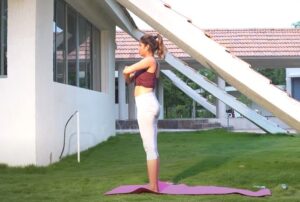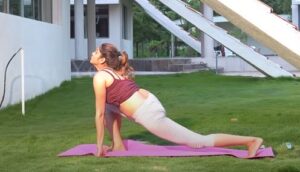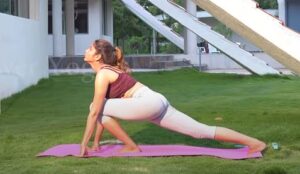Sun Salutation (Surya Namaskar) has become the default beginning point to warm up in many yoga classes today. However, the edition performed in classes only targets the hip joint. I prefer to stick to the classic Sun Salutations (Surya Namaskar) to warm up the body as they offer a fuller range of motion in all major joints.
Beyond being a perfect aerobic exercise, Surya Namaskar is also considered to have an overwhelmingly beneficial impact on the body and mind.
Surya Namaskar is usually performed early in the morning with an empty stomach. Besides good health, Surya Namaskar also offers an opportunity to express gratitude to the sun for sustaining life on this planet.
Benefits:
- It helps to improve cardiovascular health.
- It stimulates the nervous system.
- It helps to stretch, flex, and tone the muscles.
- Sun Salutation is a great exercise to control weight loss.
- It strengthens the immune system.
- It increases cognitive function.
- It improves general health, strengthens the body, and relaxes the mind.
How to Do:
- Standing Mountain Pose (Tadasana)
Stand with your feet hip-width apart. In prayer pose, bring the palms together. Relax your thumbs on the sternum and take a few breaths.
- Upward Salute (Urdhva Hastasana)
Inhale as you sweep your arms to the side and overhead. Kindly arch your back and face up towards the ceiling.
- Standing Forward Fold (Uttanasana)
Exhale as you fold your hips forward. Bend your knees if you need to. Relax your hands beside your legs and bring your nose as close to your feet as you can.
- Half Standing Forward Fold (Ardha Uttanasana)
Inhale as you raise your torso halfway; lengthen your spine forward such that your back becomes flat. Your torso should be parallel to the floor. Keep your fingertips on the floor, or put them to your shins.
- High Lunge
Exhale and step your left foot back into a lunge. Center your right knee over the heel, so that your shin is perpendicular to the floor, and bring your right thigh parallel to the floor. Firm your tailbone against your pelvis and press your right thigh against the resistance. Inhale, you will reach back through your left heel. Lengthen the torso looking up towards the ceiling. Look forward without being strained.
- Downward-Facing Dog Pose (Adho Mukha Svanasana)
Exhale and take your left foot back. Stretch the palms and soles. Press the front of your thighs back as you press your inner hands strongly against the floor. Think that your torso is being stretched like a rubber band between your arms and legs.
- Four-Limbed (Chaturanga Dandasana)
Inhale and leap into Plank Pose (High Push-Up Pose) with your hands under your shoulders and your legs hip-distance apart. Exhale as you drop your body to the floor. Keep your elbows tucked into your sides. If you need to, come to your knees for Half Chaturanga. Otherwise, leave your legs straight and go back through your heels.
- Salute with eight parts or points (Ashtanga Namaskara)
Continue exhaling as you gently bring your knees to the floor. Take your hips back slightly, slide forward, and rest your chest and chin on the floor. Raise your hips a little. The two hands, two feet, two knees, the chest, and the chin (eight parts of the body) should touch the floor.
- Upward-Facing Dog Pose (Urdhva Mukha Svanasana)
Inhale as you pull your chest forward and straighten your arms. Drag your shoulders back and lift your heart to the ceiling. Push through the tops of your feet, raise your thighs off the floor, and keep your leg muscles fully engaged. Keep your elbows tucked in toward your sides.
- Downward-Facing Dog Pose (Adho Mukha Svanasana)
Exhale and once again stretch the palms and soles. Press the front of your thighs back as you press your inner hands strongly against the floor. Think that your torso is being stretched like a rubber band between your arms and legs.
- High Lunge
Inhale and bring your left leg upfront. Center your left knee over the heel, so that your shin is perpendicular to the floor, and bring your left thigh parallel to the floor. Firm your tailbone against your pelvis and press your left thigh against the resistance. Lengthen the torso looking up towards the ceiling. Look forward without being strained.
- Half Standing Forward Fold (Ardha Uttanasana)
Exhale as you bring your right leg to your left leg. Inhale as you step or leap between your hands. Raise your torso halfway, lengthening your spine forward such that your back is flat. Your torso should be parallel to the floor. Keep your fingertips on the floor, or put them to your shins.
- Standing Forward Fold (Uttanasana)
Exhale as you fold the torso over your thighs. Bend your knees if you need to. Relax your hands beside your feet and bring your nose to your feet as long as you can.
- Upward Salute (Urdhva Hastasana)
Inhale as you reach your arms out to the side and stretch out once again. Kindly stretch your back and look up to the ceiling.
- Mountain Pose (Tadasana)
Exhale as you come back into Mountain Pose. Bring your hands into prayer position. Rest your thumbs on your sternum.
Contradictions:
- Heart patients should consult their doctor before performing this yoga routine.
- If you have back issues, you must perform Sun Salutation under the supervision of your yoga instructor.
- People with high blood pressure problems should avoid this sequence.
- Arthritis contributes to the stiffness of the knee and therefore hinders movement. Since Surya Namaskar includes knee motions, you must be careful if you are a patient with arthritis.
- Persons suffering from hernia must always refrain from performing Sun Salutation.
- If you have a serious wrist injury, you may skip this yoga sequence.
- Pregnant women should not perform Sun Salutation because it places weight on the back and abdominal areas, causing damage to both the mother and the child.
- Women must also avoid Surya Namaskar during their periods.
Timing: 1-2 Round (takes around 4 minutes)














“Nice article, really well explained. Mantras are really important while doing surya namaskar, it is a traditional way and one should not forget that. Without mantras, the powerfulness of yoga poses is not as much as it should be. Thank you for sharing this.
Glad you liked the article Somya🙂